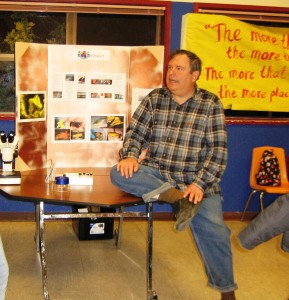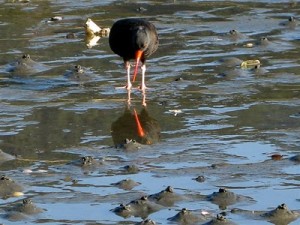Community members packed the Eastsound Fire Hall yesterday as the County’s Marine Resource Committee (MRC) celebrated the success of Kwiáht and Beach Watchers in their “Community Science” efforts.
But arguably, the stars of the ”Community Monitoring Roundtable” show were three young oystercatchers, hatched on Indian Island this summer, in part through the vigilance and care of the Beach Watchers and Kwiáht. The oystercatcher fledglings’ existence points to the value of Community Science projects such as the ones taking place on San Juan County beaches through [intlink id=”8482″ type=”post”]Marine Health Observatories[/intlink].
The “Community Monitoring Roundtable” was preceded by the regular meeting of the MRC. Then Susan Key, coordinator of the Roundtable for the MRC, described the proliferation of non-governmental marine monitoring events and said, “We need to look at the efforts and see if the questions we’re asking, as a community, of our state and federal connections, can be answered.” As the MRC develops its work plan for 2011, Key said, “We look at how to develop community efforts, and we see a great deal of promise.”
The data collection and reporting “couldn’t happen,” Key said, without the efforts of Russell Barsh, founder-director of Kwiáht, and Shann Weston, coordinator of WSU Extension Beach Watchers.

Russell Barsh shares the excitement of scientific research at the Orcas School's Science Fair last spring
In the Coast Salish language of Puget Sound, “Kwiáht” means “a spiritually clean place.” Kwiáht’s Articles define its twofold mission as:
- scientific research in the service of good stewardship of cultural and biological resources in the San Juan and Gulf Islands,
- the improvement of local science education
Beach Watchers students spend 100 hours in training, traveling throughout the Salish Sea and learning about its ecosystem from many talented instructors. They give 100 hours (and more) back to the community by assisting scientific research,stewardship projects and by providing education and outreach to residents and island visitors. The Beach Watchers classes take place annually.
Weston spoke to the gathering about “what citizens of this county have been doing…they come in and work, without regard to what their background or training is.”
She differentiated between “Citizen Science” where the results benefit the participating group, and “Community Science’ where the results are enjoyed by the community. “Our boss is the place,” she says of the Beach Watchers’ role.
The Beach Watchers’ commitment includes outreach and education. Weston spoke of the “sense of overwhelm and despair” that may come from awareness, and said that the Beach Watchers “go backwards for success;” first they engage in action, and then formulate questions from what their observation has shown them.
The impact of human development on marine environments is apparent with the data obtained in three of the five areas observed: East Sound, Friday Harbor and Fisherman Bay, Weston said.
Concluding with the metaphor of the Blind Men and the Elephant, where each person described an elephant from his individual perception of an elephant’s leg, or trunk, or tail, or tusk, Weston said, “I hope by putting people in the same room with our preliminary findings… we’ll start to ‘see the elephant’.”
Susan Key gave a slideshow presentation of the growth of community monitoring projects around the world. “People are asking questions and learning about our own backyards, collecting accurate and usable data and educating others.”
With limited time and energy, the Marine Health Observatories, MRC, BeachWatchers and Kwiáht hope to further community science and to:
- Improve the understanding of how humans affect nature and local marine life
- Share the knowledge with islanders, visitors and other researchers
- Involve children in meaningful research and discovery
- Teach responsible marine stewardship
Russell Barsh described the projects in San Juan County:
- Waldron Citizen Science Program, a pilot project “to make science interesting and worthwhile to the community;”
- Lopez Salmon team at the south end of Lopez Island, studying the juvenile salmon nursery;
- Indian Island on Orcas Island, a Marine Health Observatory that exhibits an intact eco-system with fish, birds and mammals that is uniquely impacted by its “cheek to jowl” position with the village of Eastsound, and Urban Growth Area (UGA);
- Friday Harbor Marine Health Observatory, also impacted by human development;
- Fisherman Bay Project on Lopez Island, that shows significant loss of fish and eelgrass, and a varied seabird population.
Each project presents its challenges, Barsh said, “and gives us a focal point for talking about why it really matters.”
Barsh described the common features of the Community Science projects developed through the MRC, Kwiaht and Beach Watchers:
- A core team of 8 to 10 people who are committed to the time and energy involved in the project
- Site-specific identification of species, involving location, measurement and replication
- Linked websites
- Community reporting events
- Membership by community businesses and Chambers of Commerce
- Network level workshops
- Rigorous quantitative methods.
Barsh emphasized the last feature, saying “the whole thing rests on good science, determined reliably, repeatedly and fitting the hypotheses about the drivers of change and the responses from the ecosystem.”
With “plenty of training and plenty of tech support,” Barsh commends the community observers as having “built independent expertise with confidence and accuracy.”
Barsh described some of the outreach and educational work done with the schools, particularly the student tech interns such as Katherine, who designed, built and tested two sampling instruments; and Elli Blaine, who evaluated contaminants in fish communities using mass spectrometry. Orcas High School student Annalies Schuh, and marine science teacher Marta Branch reported to the Community Monitoring Group.
Community scientists have “just started” to learn and study the questions and hypotheses arising their observations. Barsh talked about the “Holy Grail” of local community scientists – the disappearance of eelgrass and the diminution of eelgrass density. Data collected show that the highest number of micro-organisms are at the fuel dock in Friday Harbor, while the greatest diversity of micro-organisms are found at the Friday Harbor labs. From such information, hypotheses can be formed and tested.
Back to the humble oystercatchers as a poster child for the value and success of community science. Barbara Bentley, Ph.D biology researcher, and a specialist in tropical biology, described herself as “as much a newcomer as anyone else” when it comes to community science on Orcas Island. She shared the excitement when, for the first time in 10 years, oystercatchers made their nest on Indian Island. This species had been driven off by Canada geese and human interference.
But when Beach Watchers observed two of the birds nesting on Indian Island last spring, they monitored what Bentley called “the human impulse to ‘conquer’ Indian Island.” On June 28, Bentley reported,
“The [three] babes have grown fast and are already flying around with their parents. Look for a flock of 5 flying loosely together around the island — making a wonderful chip/cheep racket. The young are still dependent on the parents for food, so if you see the birds foraging, the parents are actively poking at / piercing / digging up prey and the young are close by just walking around.
“We still need to work with the public to stay off the green areas (top) of the island. The birds are loyal (and quite territorial ) to the nest site, so the presence of a human can cause a lot of disturbance. Apparently, the birds don’t mind looking DOWN on humans, so look up from the rocks on the southwest shore and you can sometimes see them peering over the edge of their cliff.”
All summer, community scientists, particularly Bentley, warned people away from the nest on the grassy part of the island, to ensure the chicks’ health and safety.
As one of many community scientists who, in Shann Weston’s words, “appreciate the beauty and care for the wildlife of this place,” Bentley warns of the ongoing threats to the health of the Indian Island Marine Observatory and East Sound waters: The street runoff of fresh and contaminated water for all Eastsound UGA, with the outfall pipe directly north of Indian Island; and human visitation to fragile habitats. She commends the work of the Beach Watchers, saying “having people there, talking to other people, saves wildlife.”
Similar ”Community Monitoring Roundtable” meetings are planned for San Juan Island on Oct. 6 and Lopez Island on Oct. 20
Other related meetings are:
- Sept. 24 Northwest Straits Marine Conservation Initiative at the Friday Harbor Grange from 10 a.m. to 3 p.m.
- Sept. 24 Marine Spatial Mapping meeting immediately following the above meeting at the Friday Harbor Grange from 3 to 4:30 p.m.
- Oct. 6 MRC meeting at Islanders Bank in Friday Harbor, with Roundtable component
- Oct. 6 (same time as above) County Public Works Groundwater mapping project
- Oct.20, Wednesday, at Lopez Community Center, with a Shoal Bay Tour planned.
- Oct. 28 Indian Island Marine Health Observatory Report to the “Community at the Orcas Center at 5:30 p.m.
- Nov. 5 and 6 Northwest Straits sponsors MRC conference at Rosario
For more information, contact the MRC through Mary Knackstedt at 360-370-7592, or maryk@sanjuanco.com
**If you are reading theOrcasonian for free, thank your fellow islanders. If you would like to support theOrcasonian CLICK HERE to set your modestly-priced, voluntary subscription. Otherwise, no worries; we’re happy to share with you.**









Thank you for the very complete overview of this meeting. I wasn’t able to attend, but studying the science of Orcas Island is something we should all care about.